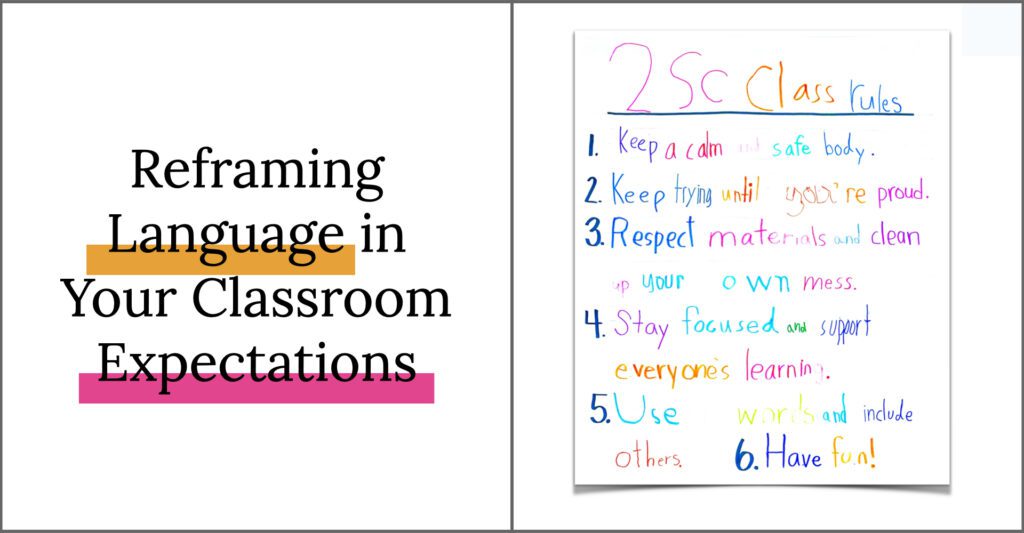
Our words matter. We’ve heard that before and maybe glossed over it. But today let’s dig into positive language in the classroom, specifically in our classroom expectations and rules. Why does it matter? How do I start making these shifts? Where does it fit into my day? I’ve got you covered with all of this and more.
What Is Positive Language? (And why it needs to be in your classroom expectations!)
Let’s make sure we’re on the same page. When I’m talking about reframing/including positive language in the classroom, I’m talking about a few things:
- Word Choice
- Tone
- Our belief in our students’ abilities and intentions (asset model)
Together these components have a profound impact on how our students see themselves as individuals and members of our classroom community. Our language choices help our students feel safe, valued, and respected.
When we use positive language in the classroom, we:
- Use clear, direct instructions focusing on what to DO, instead of what NOT to do
- Give specific praise about what students have done well- so that they can repeat it
- Acknowledge students’ feelings, avoiding toxic positivity
- Provide examples, via modeling, anchor charts, and sentence starters for students to refer to
- Bring an asset model of thinking to our conversations with students, talking about what they CAN do
- Refrain from talking about students in a way that labels them indefinitely (high or low, good or bad)
- Model how we want our students to speak to others (and how they should expect to be spoken to)
Why Language Matters
There are quite a few reasons that our language positive language in the classroom is essential.
Inclusivity
Our words build and foster our classroom communities. How we talk to and about students (both in their presence and with colleagues and caregivers) can put up or knock down barriers to our students participating fully in our classroom communities. When we come from an asset model of thinking about our students, our words follow.
Supporting Students with Trauma
We can be mindful of our students that have experienced trauma by using positive language in the classroom. Keeping a calm, predictable tone, as well as clear expectations will help students feel comfortable and safe in our classroom. These language choices are best practices for ALL students, so as we move towards more positive language in the classroom, everyone wins.
Supporting Executive Functioning
Using clear, direct language and consistent expectations and routines benefits our students that struggle with executive functioning or students with ADD or ADHD. Incorporating positive language in the classroom helps our students understand what to do in the classroom and what to expect from their teachers. When these aspects of school are consistent, our students do not need to worry about what they should do at math time or how their teacher will react. They can instead focus on the academic or social skills at hand.
Considering Student Experience
Last, but definitely not least, incorporating positive language allows us to be mindful of kids who have previously heard nothing but “no,” “don’t,” or their name used in a negative context. Many of our students, myself included, come to school feeling like a failure. Students have had experiences at school and home where they are frequently reprimanded for their mistakes, leading them to feel like they can’t do anything right, which in turn, you guessed it, keeps that cycle going. Positive language can be an impactful reset for these students.
When we center our practice on positive language, students will:
- See that their teacher noticed positive things that they’ve done or said
- Hear a teacher give a suggestion of something to do that does not start with, “No, Don’t…”
- Are met with a teacher that calmly helps them make a mistake right, rather than jumping to an unrelated punishment
- Learn from their mistakes rather than be further marked by these mistakes
- Have the motivation to try again
Can you feel the shift that this has on our classroom community? Can you sense the shift in how students see themselves and their peers?
Ok, Jillian, I’m all in on positive teacher language! But how do I get there? How do I make ALL of these changes?
I’m a huge believer in being a life-long learner. I didn’t get here overnight and I’m still working on positive language in the classroom. It’s ok to take your time, adding things as you’re ready. Let’s dive in and talk about a few places to start.
Classroom Expectations and Rules
Establishing classroom expectations and rules, both verbally and in writing where students will see it all year long, is an amazing place to start using positive classroom language. I work with my students to co-create our classroom rules during the first few weeks of school. We create and write our rules as a class with everyone’s input and writing.
When we discuss the rules and expectations we might need in our classroom so that ALL students can reach their goals, hands fly up. Students share ideas like, “No running,” “Don’t yell,” and “Don’t be mean.” While these are all things that would help our classroom run more smoothly, it’s worth it to push the conversation further.
This exercise helps us reframe our language for the positive AND forces us to share clear, descriptive cues about what we want students in our class to do. We’re on the right track. But I wonder:
- If you’re not running (which you shouldn’t be doing in our classroom), what would you be doing?
- Instead of yelling, what do we want our friends to be doing?
- If we don’t want our friends and teachers to be mean, what do we want them to do?”
The Switch to Positive Language
Here’s where the magic happens! Here’s where we get the good stuff! Clear, descriptive, direct classroom expectations, like:
- Keep a calm safe body
- Focus on your work
- Use kind words
- Clean up your space
To make things crystal clear (or in January when we need a little classroom rules reboot), we make a “Looks Like/ Sounds Like” T chart for each rule.
When we focus on what not to do, our students are left without a clear picture of what they could be doing. And in that space between what not to do and what they should do… well, you know what happens.
You might be reading this once your classroom expectations and rules are already established. All is not lost! We can apply this practice to teaching a new math game, getting ready for an assembly or new activity, or reestablishing routines after a break. Using positive language in the classroom to guide students in discussions of classroom expectations is a practice worth revisiting MANY times during the school year.
Redirection of Student Behavior
How we redirect student behavior is so impactful: for how our students see themselves, and for their relationships with their peers and teachers. Prioritizing positive language in the classroom when we redirect our students may take some conscious effort, but let me tell you, it shifts our interactions with our students for the better!
I’m sure we can all think of some things that happen in the classroom during the day where our knee-jerk instinct is to shout a student’s name across the room followed by “Stop!!!”. We know what happens next: all learning stops, all students look over to that child, that child feels embarrassed… and this situation escalates. Not exactly productive, safe, or calm.
In these situations, I make it a point to go to the child for a private conversation, not one that involves the whole class. In our conversation, we focus on:
- Observations of expected things the student has been doing
- The progress they’ve made
- What’s getting in the way of meeting the expectation (Do they need help to review the assignment? Do they need a tool or a break? Did something happen at recess or at home?)
- Logical consequences or ways that they can make it right if needed
Conversations in our classroom community
Positive language in the classroom in our daily conversations is a little step that has a big impact over time. When I am leading a discussion or participating in a discussion with a small group of students (either in a lesson or an informal conversation), I make those shifts in the conversation and rephrase things with positive language in mind.
Eventually, positive language happens more organically for myself and my students. Some of my favorite places to support positive language in our conversations are:
- In whole-class discussions about our day. We go from saying, “We didn’t have any problems in line today” to “We walked in a calm, quiet line past other classrooms today.”
- In solving a conflict. We go from saying, “She never listens to me when we’re playing that math game” to “I would like it if my math partner waited for me to share my idea.”
- In complimenting someone. We go from saying, “Great job” to “I noticed how you carefully colored that picture” or “Wow, you were really brave when you read your story to the class. You read clearly and loud enough for everyone to hear.”
I hope that you’ve found a few ways to interject positive language in your classroom. Do you have some favorite ways to incorporate positive language into your routines or conversations? I’d love to hear about it!

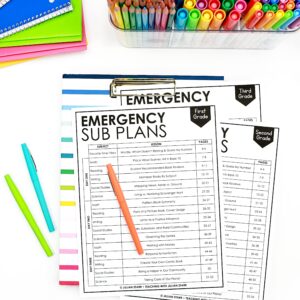




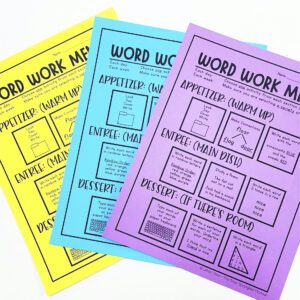
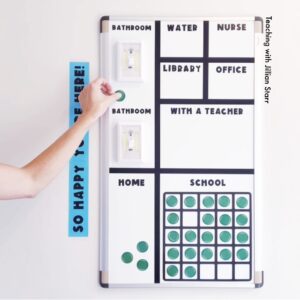
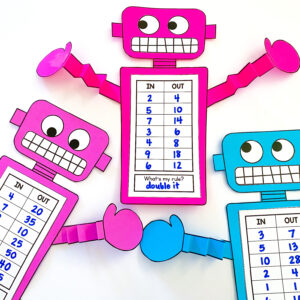


Leave a Comment